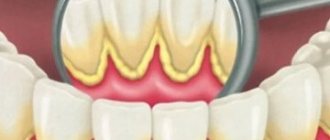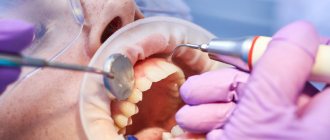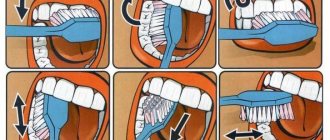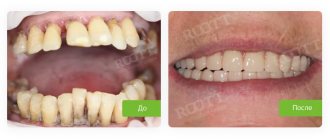Tartar formation and complications of this condition are one of the most common reasons for visiting a dentist. But not everyone knows that the appearance of this unaesthetic plaque can be prevented, and that prolonged absence of treatment for already formed stone can lead to tooth loss.
Experts diagnose almost all people with tartar, the treatment of which, as a rule, is quite expensive. To understand how you can avoid this problem, you need to understand what tartar is and how you can prevent its occurrence.
What is tartar
Tartar is hardened soft plaque. When brushing teeth incorrectly or poorly, a soft mass consisting of fragments of the mucosal epithelium, food particles and colonies of bacteria accumulates on their surface and in the interdental spaces. Under the influence of saliva and substances produced by bacteria, the mass gradually hardens, turning into tartar. Hard deposits may be observed on the back surfaces of teeth and between teeth, in which case they are classified as supragingival calculus. Gradually, under the influence of gravity and chewing movements, the stones move under the mucous membrane of the gums and are classified as subgingival.
Ultrasound is a modern way to combat tartar
Preventive cleaning of teeth from stone with ultrasound has long been a mandatory procedure in civilized countries. In our country, there is no such practice yet, so patients are more negligent about their health and most often turn to the dentist when there are obvious health problems.
The procedure for cleaning teeth with an ultrasonic scaler in dentistry is carried out by a hygienist or periodontist. The specialist assesses the condition of the teeth and gums, excludes contraindications, selects the necessary attachment for the device and begins treatment.
In case of increased sensitivity of the enamel and deep cleaning of the subgingival area, the doctor may use local anesthesia - this will make the patient more comfortable during the procedure.
Under the influence of high-frequency ultrasonic vibrations, any dental deposits are destroyed, and pathogenic bacteria are destroyed from the surface of the teeth and from periodontal pockets. Ultrasonic cleaning lasts about an hour and ends with an enamel polishing procedure. You will not only see, but also feel the result: your teeth will become clean, smooth - and no hint of dark plaque.
In children, teeth cleaning from tartar and plaque with ultrasound is carried out after changing the primary bite to a permanent one and exclusively for medical reasons.
Despite the fact that ultrasonic cleaning is a safe procedure, it has a number of contraindications:
- general somatic diseases in acute form
- colds and ARVI
- infectious diseases
Ultrasound should be used with caution in patients with an artificial cardiac pacemaker.
Ultrasonic tartar removal is the most effective and fastest way to make your smile attractive again. For preventive purposes, this procedure is recommended to be carried out every six months, and for those who wear braces, even more often - once every 3 months.
In what cases does stone plaque form?
The reason for the formation of tartar is poor quality dental care, in which soft plaque is not completely removed. High mineral content causes plaque to harden. Using a too soft toothbrush, lack of attention to the interdental spaces and gum margins, irregular oral hygiene, etc. are the main sources of the problem.
But there are factors that increase the likelihood of hard deposits forming on teeth:
- diseases of the digestive system and endocrine system, in which the chemical composition of saliva changes;
- malocclusions and dental defects that form particularly difficult areas to clean;
- wearing dentures, braces, brackets, plates and other structures that make it difficult to properly clean teeth using a traditional brush and paste;
- a large amount of carbohydrate foods in the diet, which facilitates the gluing of soft plaque particles.
Causes of congestion
- Insufficient oral hygiene, incorrectly selected hygiene products.
- Eating a lot of sweets, sticky foods, rich in light carbohydrates, and at the same time a small amount of solid foods, such as vegetables, in the diet.
- Abuse of products that have a coloring effect. Tea, coffee, cola, carbonated drinks - all this leads to the fact that the plaque turns brownish and, after hardening, spoils the smile.
- Diseases of internal organs. Patients with diseases of the gastrointestinal tract and endocrine system are prone to the formation of plaque on their teeth.
- Partial edentia, malocclusion, severe crowding of teeth.
Patients with bridge prostheses are at risk. The bridge is fixed on the supporting tooth. Food particles get trapped under the crown. In this case, cleaning plaque on teeth with conventional means is impossible. As a result, it grows, microorganisms attack the gums and supporting teeth, and it becomes mobile. If you have dentures, you should definitely visit your dentist for professional cleaning.
Types of Tartar
Plaque is divided into two categories. First, supragingival stone appears, the cause of which is poor oral hygiene. Such deposits are located above the upper edge of the gingival crest, so they are easily diagnosed during a routine examination.
The characteristic features of supragingival tartar include:
- Localization on the inner surface of the tooth, from the side of the tongue;
- White or yellowish tint;
- The consistency is hard or clay-like.
The plaque is unstable, so it can be removed mechanically without any problems.
Subgingival calculus appears as a result of the fact that supragingival plaque descends down the root of the tooth and mineralizes. It forms in the gum pocket and is diagnosed only when using special dental instruments. Such deposits are considered age-related and most often appear in people over 40 years of age. If personal hygiene rules are not followed, it can appear at any age.
Signs of tartar:
- Dense and hard consistency;
- Light brown or greenish-black tint;
- Swelling and bleeding gums.
Symptoms of Tartar
The first symptoms of tartar are a change in the color of the enamel on the upper molars and lower incisors. Soft yellow or gray plaques appear. First of all, tartar forms in areas where there is no self-cleaning of the surface during the process of chewing food or rinsing: the interdental space, the inner walls of the tooth.
Primary symptoms:
- Bad breath;
- Mild itching of the gums;
- Slight bleeding.
If no measures are taken to remove plaque, it begins to mineralize, becoming harder. As a result, the gums may become inflamed and there will be severe swelling and redness. Detachment of the gingival margin is possible, which leads to the appearance of a periodontal canal.
Possible complications
Plaque is the #1 cause of gum inflammation (gingivitis and periodontitis). Therefore, in the long term, this problem can even lead to tooth loss. In addition, deposits are localized on the teeth, and the bacteria that make them up lead to the destruction of enamel, the appearance of caries and other dental diseases.
The aesthetics of a smile are also disturbed, an unpleasant and even putrid odor from the mouth occurs, which affects a person’s psychological comfort. Another consequence is disruption of the digestive tract, since plaque is bacteria and, along with food, they also enter the stomach.
What are the dangers of tartar?
In cases where tartar has already formed, treatment should be carried out immediately. Otherwise, it moves under the gums and leads to severe disorders of tissue metabolism in soft tissues.
As a result, acute or chronic gingivitis develops, the ligamentous apparatus of the tooth becomes inflamed and, as the most severe complication, periodontal disease develops - atrophy of the tissues that provide support to the tooth. As a result, a person who has developed subgingival tartar in the future faces the need to remove teeth that have lost stability and are no longer able to perform their functions.
Methods for treating tartar
Treating tartar on your own at home is not possible. Tartar removal is performed using practical and painless methods in the dentist’s office:
- Ultrasonic cleaning. This is the treatment of tartar with a scaler. The equipment generates low-frequency ultrasonic vibrations that destroy dental plaque. After this, the dentition is washed with a stream of water, and the enamel is ground and polished.
- Air Flow whitening system. In this case, cleaning is performed with an abrasive compound supplied under pressure through a special nozzle. The composition includes air, water and sodium carbonate. The equipment does an excellent job of cleaning the interdental space and effectively removes stubborn plaque.
- Laser cleaning. This is a non-contact technique that does not cause discomfort or pain. Tartar cleaning is performed with a directed laser beam, the remaining particles are washed out of the oral cavity with a water-air jet.
How does an irrigator help with tartar?
One of the most frequently asked questions about whether an irrigator removes tartar can be answered this way: the irrigator helps with the prevention of tartar. It can only help if deposits have just begun to form and they have not yet formed stone. Regular and thorough brushing with a toothbrush and toothpaste, flossing, and completing your oral care with a irrigator can greatly reduce the risk of tartar.
But even in this case, tartar cleaning should be completed in the dentist’s office: the doctor will grind the enamel to eliminate roughness that facilitates the formation of plaque.
Products that should never be used -
Before writing this article, I carefully studied various sites that write on the topic of removing dental plaque at home. As a practicing dentist, I was somewhat shocked that such articles (by all indications) were written not just by “NON-dentists”, but by people who have absolutely nothing to do with medicine, and sometimes even lack common sense and have no idea , and what exactly do they advise.
I bring to your attention a couple of recipes that you can use to remove tartar at home. After the text of each recipe, you can read its analysis - both from the point of view of medical knowledge and a school chemistry course.
Recipe No. 1 –
“You need to make an elixir from grated black radish and lemon juice. This elixir should be consumed before bed, as well as moistened with a toothbrush and brushed your teeth.”
So, comments: the radish and lemon elixir contains nothing more than acid. Previously, in dentistry (when ultrasound was not yet used to remove dental plaque), in fact, before removing dental plaque with hand instruments, strong acids were sometimes used to slightly soften the tartar. Moreover, even after partial softening with acid, it will be impossible to remove tartar with a toothbrush or household tools.
The use of acid for removing tartar was abandoned about 40 years ago for the following reasons: 1) due to the low effectiveness of this method, 2) acid washes calcium from the surface layer of enamel, contributing to its abrasion and the development of increased sensitivity to thermal irritants.
Recipe No. 2 –
“Nut broth.
It is made by boiling 35 grams of walnut branch bark for 20 minutes in about one glass of water. Next, you need to dip your toothbrush in the broth and brush your teeth for 4-5 minutes, 3 times a day.” Comments: Try moistening your toothbrush with water and brushing your teeth with it. The effect will be exactly the same.
- Firstly, you will immediately feel how poorly your teeth are cleaned of plaque if you replace toothpaste with nut broth. Accordingly, this will lead to an increase in the amount of plaque on the teeth and accelerated formation of tartar.
- Secondly, hard dental deposits (tartar) are mineralized soft plaque.
Those. they are formed from soft microbial plaque, which was not cleaned from the teeth in time, and which was saturated with calcium and phosphorus salts contained in saliva. Thus, hard plaque is a very dense formation mineralized with calcium. From the chemistry course, you can remember that in order to dissolve calcium salts, you need a very strong acid, and not a decoction of walnut bark, which has no acidity. And as for the general use of acid to remove tartar, we have already talked about this above, i.e. this is not worth using.
Prevention of tartar formation
The only reliable and effective means of prevention is control over the quality and regularity of dental and gum care.
Be sure to brush your teeth at least 2 times a day (morning and evening), ending each procedure with the use of an irrigator. This will help remove soft plaque from areas that traditional oral hygiene products cannot reach.
In addition, it is important to monitor your overall health, promptly seek bite correction and minimize the consumption of fast carbohydrates such as baked goods, sweets, etc.
More detailed information is presented in the catalog of oral irrigators.










